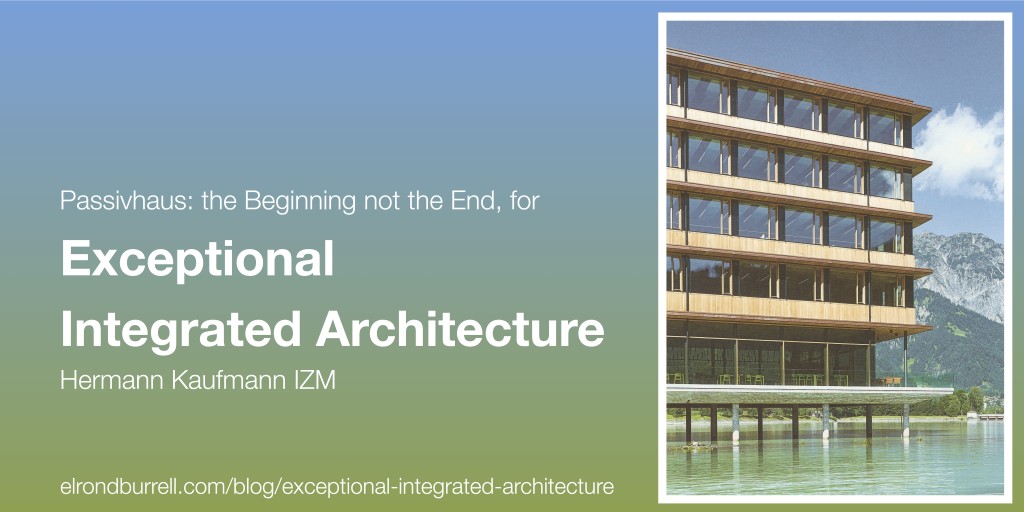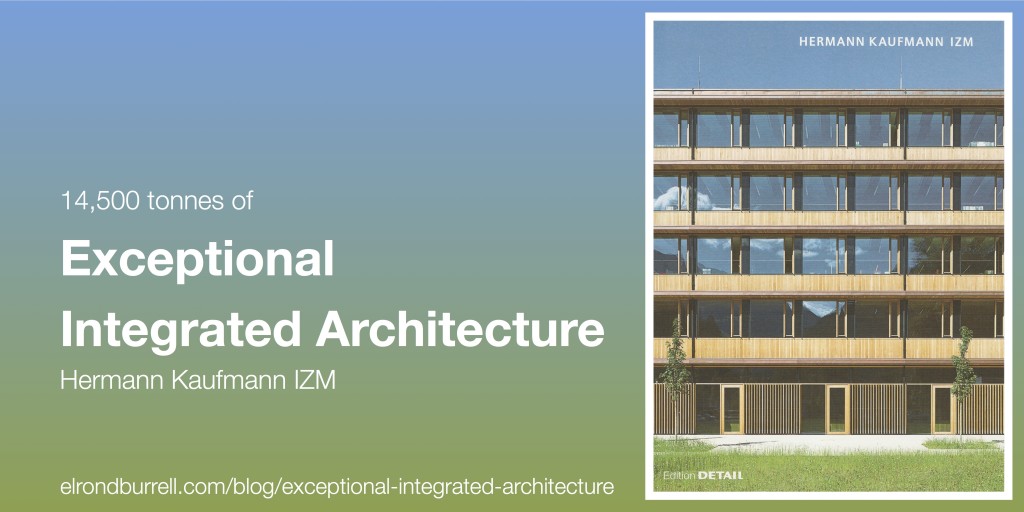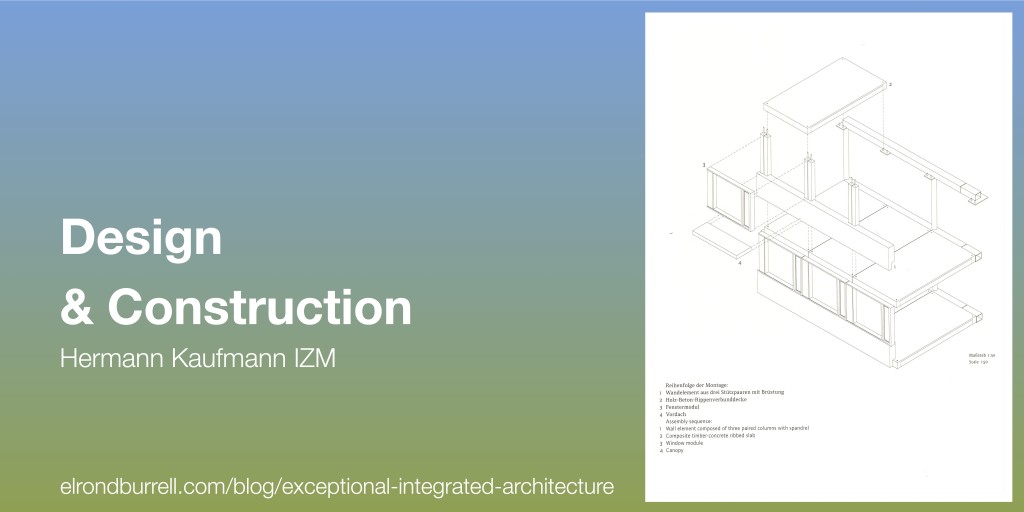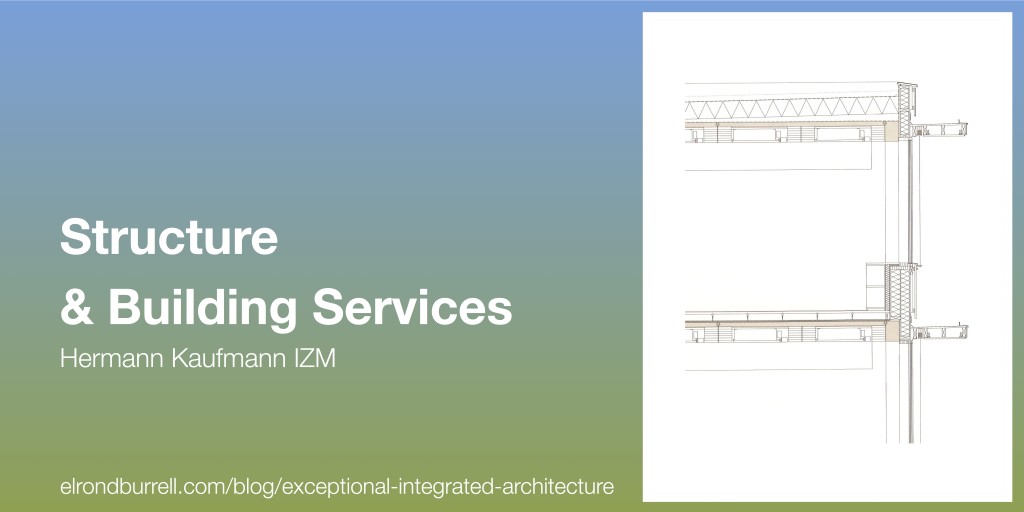This blog post is a review of “Hermann Kaufmann IZM: Illwerke Zentrum Montafon” published in April 2015, edited by Marko Sauer.
This is a beautiful book about a beautiful building. The IZM is a new 120m long, five-storey office building in the Montafon valley of the Vorarlberg region in Austria. It brings together, in a central location, both the civil and electrical engineers of the hydropower generation company, Illwerke Vorarlberg.
The Illwerke Zentrum Montafon (IZM) in Rodund is an unparalleled timber structure: with a usable floor area of over 10,000 m2, it was the largest office building made of wood in Central Europe on completion. Assembled in only six weeks, the timber construction above the concrete base is the first application of the LifeCycle Tower (LCT) system on the free market.
The building is an exemplar of integrated architecture. The alpine setting, materials research, modern technology, prefabrication, traditional craftsmanship, low energy / low carbon design, and social contribution all play their part in making the IZM a work of stunning Passivhaus architecture.
“Hermann Kaufmann IZM: Illwerke Zentrum Montafon” is an elegantly restrained monograph of essays, beautiful photographs and clear drawings. It is, in a sense, reflective of the building itself. It maintains the very high standard of presentation and technical detail that can be found in all Detail magazines and books.
Passivhaus architecture is integrated architecture. This book details an exceptionally beautiful work of integrated architecture.
The book is broken down into ten chapters, each of which can be read as a stand-alone essay.
Three of the chapters are by guest contributors and these cover how the building exploits the strengths of the materials used, the leitmotif of Hermann Kaufmann’s work and the integration of art and architecture.
The other chapters, by Marko Sauer, cover; the values of the project, the influence of the local context, the construction process, the materiality and impact on the interior spaces, energy and sustainability, the building exterior and the landscape, and the design of the office spaces.
Design & Construction
The IZM is the first commercial application of the LifeCycle Tower (LCT) system, despite the fact that it’s not a tower. The LCT system, developed by Hermann Kaufmann, Arup and Cree Rhomberg, is essentially a kit of glulam and concrete hybrid parts that can be assembled fast and accurately, whether the building is a tower or not. The original LifeCycle Tower (LCT1) tested the system and proved the research in real world conditions. If you’re not familiar with it, I suggest you watch the following 5 minute video.
The LCT system makes the most of the inherent strengths and differences of timber and concrete by combining them. Aside from the specific materials, as a construction system it influences the design through the constraints that prefabrication and transportation of components imposes. In return, it offers incredible speed and precision of assembly.
Uniquely the system leaves the elements of structure and construction visible within the building, no plasterboard linings are needed. In this way, the system positively contributes to the internal aesthetics whilst meeting demanding structural, fire and acoustic requirements. The result is an industrial scale process imbued with finely crafted timber details.
In the IZM, the system produces free span structural bays with only a single row of columns offset from the centre of the building’s long axis. The facades reflect the regular rhythm of paired columns that make up each bay of the LCT system, but are otherwise unconstrained. LCT1 was clad in a metal panel system that emphasised its verticality. IZM, in contrast, is clad in horizontal bands of oak boards alternating with ribbon windows and flat canopies, all serving to emphasise the horizontal nature of this building.
Much like biology, this results in a body that expresses the anatomical particularities of its individual parts. The rational static system determines the structural and spatial organisation of the four upper storeys. It sets limits in terms of span and dictates the construction sequence. For façade arrangement, on the other hand, it offers greater design freedom. The new office building utilises this scope and, through the external envelope, addresses a further design requirement: to ensure that all workplaces offer the same quality and help to bridge the firmer divide between functions and hierarchies at the Vorarlberg Illwerke. The façade represents a supreme blend of technical and aesthetic design.
The book contains numerous clear drawings and excellent photos of the components and the construction sequence. Together they illustrate both the LCT system and its specific application on this building, the IZM.
Integrated design and construction – the form and aesthetic are intimately tied to the construction system and methodology.
Structure & Building Services
The IZM exhibits exceptionally well integrated building services and structure. Due to the nature of the LCT system, the structure is an integral part of the construction system. The building services are then integrated within the structural rhythms created.
The innovative LCT system … basic module is a prefabricated composite ribbed slab element made of timber and concrete. Four glued laminated (glulam) timber beams are joined to a slender concrete slab that also encloses the heads of the beams. The basic module simplifies the building process: fire protection is already established by comprehensive tests and no longer requires certification; the structural properties are known and quantified. Much wider spans with smaller cross-sections can be built with the hybrid slab elements. The concrete slab adds mass to the building, reducing sound transmission and damping vibrations. Connection details are designed to allow for the varying tolerances of individual trades – centimetre accuracy for masonry and concreting work and millimetre accuracy for the carpenter.
What isn’t mentioned though, is that the system also provides integrated ceiling voids that seamlessly accommodate the building services. The cables, pipes and ducts that make up the distribution systems of the building follow the same clearly laid out rhythm as the structure. While this isn’t specifically written about in any of the essays, it is illustrated clearly in a number of drawings and apparent in many of the beautiful photographs.
Flush ceilings between the glulam beams are yet another example of exemplar integration. Linear light fittings alongside linear supply air diffusers alternate between the left and the right of flat radiant heating panels. Fire detection and sprinklers also follow the same rhythm within the composition of ceiling elements.
Where there are timber slat ceilings, filigree LED strips are set in the same plane as the timber and form a bespoke installation by light artist Miriam Prantl. The light fittings are staggered to create a counter rhythm to the timber slats and feature a range of subtly different light colours. There is a chapter specifically focused on the integration of art and architecture. It covers the various artists involved in the project and their installations in the building and the surrounding landscape.
Integrated structure and building services play an important role in the quality and aesthetic of the internal spaces.
Passivhaus & Wider Sustainability
What role does Passivhaus play in this example of exceptional integrated architecture? It is not an end in itself; Passivhaus is part of a wider sustainability strategy.
In addition to achieving certification to the international Passivhaus Standard, the IZM also achieved a gold “Green Building” label from the German Sustainable Building Council (DGNB) and the Austrian Sustainable Building Council (ÖGNI). This is a broad green building rating system somewhat similar to BREEAM and LEED. It has 40 criteria that cover ecological, economic and socio-cultural aspects, as well as technical quality and operating processes. Some areas that were specifically given attention for the IZM include; day lighting quality, public accessibility, interior hygiene, user controls, disabled access and being “bicycle friendly”.
In the context of assessing building efficiency, a question asked by the visionary architect and designer Richard Buckminster Fuller is often cited: “How much does your building weigh?” In the case of the Illwerke Zentrum Montafon (IZM) in Rodund, the answer would be 14,500 tonnes. This short and precise question about the weight of a building addressed a wide range of issues, including the choice of material and its efficient application.
…
Today, Fuller might have rephrased his question as follows: “How big is the ecological footprint of your building?” Timber construction offers the prime solution for minimising this footprint. In terms of its carbon profile, a building with a timber supporting structure – the part of the building with the most weight – scores some 56% better than conventional constructions. Moreover, wood is generally acknowledged as the only material that can take up the greenhouse gas carbon dioxide.
Energy and carbon studies were undertaken comparing different approaches that could have been taken to the design and construction of the building. The book provides relatively light detail of the studies but does include two graphs comparing the results of four different scenarios considered. The studies demonstrated that the IZM as built has only 46% of the carbon footprint of an equivalent building with a conventional structure and built to the minimum regulations for energy consumption.
And, as the graphs show, Passivhaus clearly plays an important role in reducing the carbon footprint of the building. So does the extensive use of timber.
There was also considerable attention paid to the social sustainability of the building. It brings together diverse groups of the organisation into the same facility, breaking down barriers previously reinforced by physical separation and distance. The architecture creates a beautiful, democratic workplace, doing away with the traditional hierarchies of the company. The building is very accessible to the public, including disabled people.
Illwerke Vorarlberg is one of the largest employers in the region. By providing a stunning new facility and career opportunities, the company makes a positive contribution to the community.
Integrated Passivhaus & wider sustainability underpin the design and construction of this stunning building.
Passivhaus: the Beginning not the End, for Exceptional Integrated Architecture
Now that you’ve read this far, you may have realised that there is very little in this review specifically about Passivhaus. This is also true of the book: Passivhaus only features briefly in one essay on energy and environment and otherwise barely gets mentioned.
And yet, this is an important point: Passivhaus is not the end goal.
Actually, Passivhaus should be the starting point.
Passivhaus should be the foundation of sustainable design and integrated architecture.
The IZM is a stunning work of architecture. It is a highly glazed building. It is a prefabricated timber-concrete hybrid construction. It has exceptionally low embodied carbon. It is radically energy-efficient and exceptionally comfortable.
It is integrated Passivhaus architecture. Exceptional integrated architecture.
It is an opportunity to witness the achievement of a demanding yet fundamentally basic requirement to live and work in a “high-comfort environment”, and – in line with the underlying imperative – to take this as inspiration for a widespread, diversified replication of this exemplar.
We are living in the Anthropocene and architecture must change. Passivhaus is the foundation of the change that is needed.
“Hermann Kaufmann IZM: Illwerke Zentrum Montafon” showcases a beautiful example of what can be achieved with integrated Passivhaus architecture.

All images from the book, “Hermann Kaufmann IZM: Illwerke Zentrum Montafon”, click on images to enlarge.
More information about the IZM can be found on Hermann Kaufmann’s website and in a feature article on the DETAIL website.
To purchase a copy of this book I highly recommend supporting your local independent bookshop if possible or purchasing direct from DETAIL Special Books. However, if you do choose to purchase from any of the links on this site, Amazon will pay me a small commission (at no cost to you) which will support this site. You can click on the image above to go to the Amazon page for the book, or visit my Passivhaus Books page for more information about this book and other Passivhaus books.
My thanks to de Gruyter publishing / DETAIL Special Books for providing me with a review copy of the book.




Terrific review- thanks for sharing Elrond.
Cheers James.